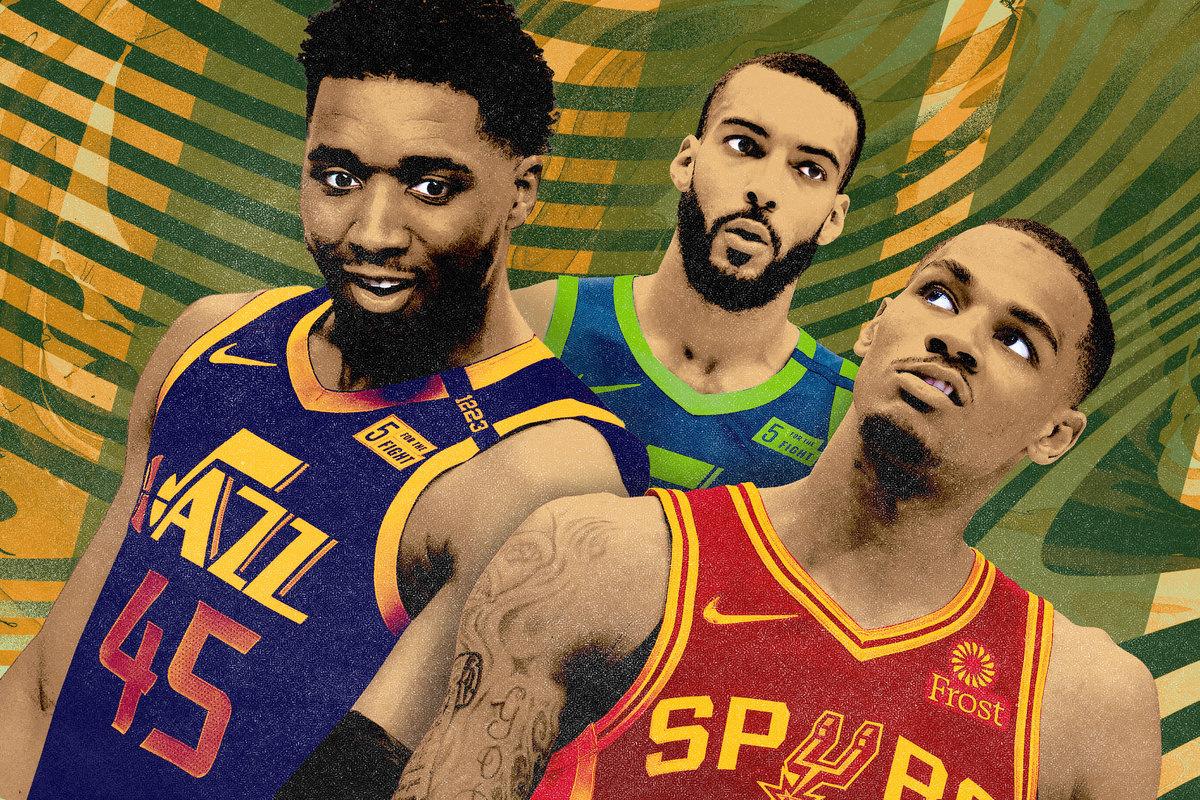
Once upon a time, all of two and three years ago, the NBA’s wealthiest coastal powers doubled as the league’s boldest teams—the franchises most likely to go all in with a flush draw.
The Lakers traded Brandon Ingram, Lonzo Ball, Josh Hart, three first-round picks, and a swap option for Anthony Davis. The Clippers traded Shai-Gilgeous Alexander, Danilo Gallinari, five firsts, and two swaps for Paul George. And the Nets traded Jarrett Allen, Caris LeVert, three firsts, four swaps, and a partridge in a pear tree for James Harden.
The commonalities among those blockbusters were obvious, their overarching message clear: All three teams were rich in veteran stars signed in free agency, so who needed the draft to build slowly from within? The Lakers could win a title in their first season with LeBron James, Davis, and role players surrounding them.
The 2022-23 offseason has flipped that dynamic, with small-market teams seizing the initiative. On Thursday, the Cavaliers completed a stealth trade for Donovan Mitchell, swapping three first-round picks and two swaps for the disgruntled Jazz star. That followed the Timberwolves’ all-in move for Mitchell’s former teammate Rudy Gobert in July, which itself followed the Hawks’ all-in move for Dejounte Murray in June.
Not too long ago, Los Angeles and New York operated as the NBA’s boldest, at-all-costs star chasers. Now, Cleveland and Minnesota are filling that role. Who needs an oceanfront beach when the Great Lakes are nearby?
This new development represents merely the latest step in the evolution around superstar trades in the NBA. Until very recently, the trade return for an All-Star was typically built around another prominent player plus a pick or two, rather than half a decade’s worth of draft choices. In 2004, Houston traded for Tracy McGrady, giving up Steve Francis and two other players, but no picks. That same year, the Heat nabbed Shaquille O’Neal in exchange for Lamar Odom, Caron Butler, and just one first-rounder. In 2007, the Celtics acquired Kevin Garnett while surrendering Al Jefferson, other young players, and two firsts (including one they were returning to Minnesota).
Even through most of the 2010s, this was the norm for blockbuster deals. On his way to the Clippers—after some meddling from commissioner David Stern—Chris Paul fetched several players but just a single first. Ditto Kyrie Irving to Boston. Toronto’s package for Kawhi Leonard included multiple players but only one protected pick.
But then Leonard helped his new team win the title in his only season in Toronto, and some combination of LeBron, Davis, Rich Paul, and Klutch Sports pushed Davis to L.A. no matter the cost. After the summer of 2019, the league had a new norm for the structure of a star return. Sure, young players like Ingram or Gilgeous-Alexander were important to clinch a deal—but the bigger draw was the haul of often unprotected picks extending far into the future, giving a non-glamour team like the Pelicans and Thunder numerous chances to count on lottery luck to find another star.
With this setup, the gulf between attractive free-agent destinations and supposed second-tier markets seemed to widen. The Lakers could afford to sacrifice any chance at bolstering their roster with youth. But the Thunder would never sign a star in free agency, the thinking went (never mind the fact that they extended George after trading for him), so they had to rely on the draft to build another contender.
“What you see OKC doing is how most teams have to do business these days when realistically looking at how to build a team,” a GM told ESPN in 2020, soon after the Lakers won a title with Davis. A team vice president added, “There’s a disparity in the access to elite players—and it’s getting wider.”
But less than two full years later, that prediction no longer seems true. While All-NBA mainstays near the end of their contracts can still force their way to glamour markets, small-market teams can access elite players in trades, too—if they’re willing to accept an uncertain future like their big-market counterparts, but without the same geographical advantages to accelerate a potential rebuild.
The key link that connects the Lakers’, Clippers’, and Nets’ deals to the Cavaliers’, Timberwolves’, and Hawks’ more recent moves is another trade by a small-market franchise. In 2020, the Bucks sent three first-round picks (two of their own and one from the Pacers) plus two swaps to New Orleans in exchange for Jrue Holiday.
Unlike the Lakers, Clippers, and Nets, the Bucks had developed their core internally: Giannis Antetokounmpo, in the draft, and Khris Middleton, via an early-career trade. But just as the Lakers—who notably missed the playoffs in LeBron’s first injury-plagued season in L.A.—needed Davis to take the next step toward title contention, the Bucks needed another star, too, and Holiday gave them the secondary creator and ace defender they sought. In the pivotal play of the next summer’s NBA Finals, with the series tied 2-2 and the Bucks leading by a single point, Holiday stripped Devin Booker and lobbed a triumphant alley-oop to Giannis on the other end. Milwaukee won the title, and the prospect of losing future draft equity was irrevocably, emphatically worth it.
It now appears as if other small-market teams are emulating the Bucks model, using the draft to build a core and then a risky trade to add the final piece. The Hawks drafted Trae Young and paired him with Murray, who should be a perfect complement in the backcourt. The Timberwolves figured no. 1 picks Karl-Anthony Towns and Anthony Edwards could score with anyone, so they shored up their defense with Gobert, a three-time Defensive Player of the Year. And the Cavaliers drafted Darius Garland and Evan Mobley plus traded for Allen, which gave them a sturdy defensive core (fifth in defensive rating last season) but flimsy offense (20th). Enter Mitchell, whose dynamic offensive capabilities but porous perimeter defense make him an ideal fit for that roster.
None of the three came cheap: Atlanta, Minnesota, and Cleveland are now effectively out of picks for years. That means they can’t build through the draft anymore; it also makes any additional upgrades more challenging because they don’t have any picks left to deal. (They could always try to retrade the new star if the situation falls apart, as the Nets did with Harden, but that’s not an easy pivot.)
All three deals, then, are immense gambles—especially because this summer’s buyers aren’t yet close to true Finals contention. Giannis was already an MVP and the Bucks were already the best regular-season team in the East before they traded for Holiday. By contrast, Towns has made only two third teams for Minnesota, Young has made only one third team for Atlanta, and nobody in Cleveland’s core has even a single selection. And rather than win a no. 1 seed last season, all three teams settled into the play-in range in the middle of the league.
Cleveland’s hope is clearly for Mitchell, who will celebrate his 26th birthday next week and has three years left on his contract, to grow alongside Allen (24 years old), Garland (22), and Mobley (21). If Mobley turns into Cleveland’s version of Giannis, it’ll sure be nice to already have Mitchell on the roster when he does. The Cavaliers don’t need to win a title right after their trade, as the Bucks, Lakers, Raptors, and Celtics did with Holiday, Davis, Leonard, and Garnett, respectively. They could grow a round at a time and still be satisfied with their progress, especially in an Eastern Conference that looks absolutely loaded at the top.
Furthermore, if the Cavaliers’ core grows and remains together for years to come, the unprotected picks they sent to Utah wouldn’t be as valuable; the Pelicans probably won’t land any prized picks from their Holiday haul as long as Giannis stays healthy. That’s an unknown in both directions—historically, picks traded many years in advance have ended up randomly scattered throughout the first round.
But the resulting league landscape looks mighty strange, given where the supposed haves and have-nots sat just a summer or two ago. This chart shows the teams with the most and least future value in terms of first-round draft assets, based on analysis of Pro Sports Transactions data. For ease of understanding, we made unprotected picks worth two points, and protected picks and swap options worth one each. (Every team not shown is within two points of neutral.)
Future Draft Pick Value Winners and Losers
Even the very top of this list shows how trades have evolved over the last year or two: The Jazz take the top spot because most of the Thunder’s future stash is protected, whereas almost every pick Utah acquired in the Gobert and Mitchell trades isn’t. And that figure doesn’t even include Walker Kessler and Ochai Agbaji, two 2022 first-rounders traded as part of the deals for Gobert and Mitchell, respectively.
Meanwhile, the Lakers and Clippers have already lost many of the picks they agreed to surrender in the Davis and George trades, so they no longer have the most barren draft boards. Now, the teams at the bottom are the small-market buyers, with the Cavaliers bringing up the rear.
In perhaps the most symbolically resonant comparison of all, Cleveland takes the bottom spot while the Knicks actually have a positive draft balance going forward, thanks largely to their draft-night deals this June. For months, Mitchell seemed headed for New York, where he grew up; the Knicks appeared the ideal example of a franchise that, like the Lakers, could comfortably sacrifice draft equity for a star.
Mitchell is a Cavalier instead, though, because a wider variety of teams has decided that taking on more win-now risk is the proper way to construct a championship contender. The gambles won’t pay off for most of them; it can’t by definition, in a zero-sum league. But the market’s been set and the pathway paved for the teams that want to try.

